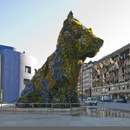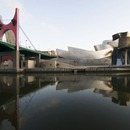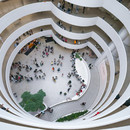Biography
Born in Toronto in 1929, Frank Owen Gehry moved to Los Angeles in 1947, where he first studied art and then devoted himself to architecture, earning his degree in 1954.In the early years he worked for Victor Gruen Associates and then studied urban planning at the Harvard Graduate School of Design.
Gehry’s work is situated in the postmodernist current and in Deconstructivism, of which he is unanimously recognized as one of the leading exponents.
In his buildings, the typical decomposition and the “seemingly illogical” reassembly nonetheless introduce a constant “dialogue between the forms of the past and those of the present”, revealing “an approach to form and materials that is inspired by painting and sculpture” (Lum).
The many distinctive features of Gehry’s style include formal lightness, oblique lines, and the use of materials that are often uncommon. Following his first commissions, typically modernist and “Californian”, Gehry opened his own firm in Santa Monica in 1962, and also began lecturing in many schools and universities.
His early works include the Danziger Studio and Residence in Hollywood (1965), the O’Neil Hay Barn (1968), and the home of painter Ron Davis in Malibu (1972).
In the 1980s, Gehry “radically transformed the very idea of the single-family home”; examples include his own residence in Santa Monica (1978) and the Benton and Norton homes (1984).
His statement about architecture and art being the same thing is fully evident at the MOCA - Museum of Contemporary Art of Los Angeles (1982), where its relationship with the surrounding urban space emphasizes the artistic imprint of the design, or in works such as the Dancing House in Prague (1996), created in the “new-baroque” style.
During the Eighties and Nineties, in addition to numerous private homes, Gehry designed some of the most important contemporary museums: the Cabrillo Marine Aquarium in San Pedro (1981), the California Aerospace Museum and the California Museum of Science and Industry, both in Los Angeles (1984); the Santa Monica Museum of Art (1988); and the Frederick Weisman Museum of Art in Minneapolis (1993).
But there are two famous museums that assume particular importance in the context of his architectural career: the Vitra Design Museum in Germany (1989), Gehry’s first project in Europe, and the world-famous Guggenheim Museum in Bilbao, Spain (1997), one of the four museums of the Guggenheim Foundation, along with those in Venice, New York, and Berlin.
Campus of the famous design firm Vitra, with objects that have written the history of design, the Vitra Design Museum in Weil am Rhein today represents a “true architectural park”, thanks to the various expansion projects carried out over the years by Zaha Hadid, Alvaro Siza and Tadao Ando, among others.
A perfect example of the architect’s deconstructivism, the Guggenheim Museum in Bilbao “presents a completely sculpted exterior structure, which follows almost organic contours, while in the interior there is not one surface that is completely flat”, as stated by Gehry himself, who also defined it as an “innovative linguistic rift” in his personal career path.
On the exterior, the curved, shiny forms of the titanium, preferred over steel, were studied one by one for the specific function they have to perform: metaphorically they fish scales, and the entire 24,000-square metre structure (recognized as one of the 12 treasures of Spain) has the form of a ship, while the windows paradoxically have a “rational structure”, by virtue of the architectural counterpoint so loved by Gehry.
In many cases, Gehry has experimented with special design software, toward increasingly complex forms. His projects completed since 2000 include the Experience Music Project in Seattle (2000); the DZ Bank building in Berlin (2001); the Walt Disney Concert Hall, the new home of the Los Angeles Philharmonic (design of 1989, completed in 2003).
Gehry’s more recent projects include 8 Spruce Street (originally known as Beekman), a majestic 76-story skyscraper in Manhattan, which won the Emporis Skyscraper Award in 2011. Characterized externally by the undulation of the façades and a “five-story brick base with a style that respects that of the surrounding buildings”, the Beekman Tower has been praised by critics for the beauty of its forms that enhance the entire New York skyline.
Inside, the building houses a school and a hospital, along with the residential units, each with a different interior configuration.
The Biomuseo in Panama City (2014), with the designed conceived in 1999, is Gehry’s first work in Latin America. With its eight galleries with permanent exhibits and large aquariums, the Biomuseo tells not only of the natural history, biodiversity, and distinct features of the isthmus of Panama, but also the country’s history, relationships and culture.
Outside, Gehry’s bond with sculpture is once again evident. With its fragmented volumes, the warm, saturated colours typical of Latin America, the sloped and almost suspended modules, the Biomuseo stands as a structure suspended at the southern entrance of the Canal, between the Atlantic and the Pacific oceans, with a surprising and fascinating visual impact.
Other noteworthy works include the Lou Ruvo Center for Brain Health in Las Vegas (2009) and the imposing New World Center concert hall in Miami (2011).
Over his long career, Gehry has received many prestigious awards, including the Pritzker Prize in 1989, the National Medal of Arts in 1998, and the Presidential Medal of Freedom in 2016.
Frank Owen Gehry selected works
- Residenza privata per Michael Eisner, Basalt, Colorado (USA), 2018
- Residenza personale, Santa Monica, California (USA), 2017
- Pierre Boulez Concert Hall, Berlino (Germania), 2017
- Facebook West Campus, Menlo Park, California (USA), 2015
- Dr. Chau Chak Wing Building, Sydney (Australia), 2014
- Louis Vuitton Foundation, Parigi (Francia), 2014
- Biomuseo, Panama City (Panama), 2014
- New World Center, Miami Beach (USA), 2011
- 8 Spruce Street (Beekman Tower), New York (USA), 2011
- Lou Ruvo Brain Institute, Las Vegas, Nevada (2009)
- Rinnovamento dell’Art Gallery of Ontario (AGO), Toronto (Canada), 2008
- IAC Building, New York (USA), 2007
- Walt Disney Concert Hall, Los Angeles, California (USA), 2003
- DZ Bank, Berlino (Germania), 2001
- Museum of Pop Culture, Seattle, Washington (USA), 2000
- Nuova dogana, Dusseldorf (Germania), 1999
- Guggenheim Museum, Bilbao (Spagna), 1997
- Casa danzante (con Vlado Milunić), Praga (Repubblica Ceca), 1996
- National Nederlanden Building, Praga (Rep. Ceca), 1996
- Sede amministrativa del Team Disney, Anaheim, California (USA), 1995
- Sede della Vitra International, Birsfelden (Svizzera), 1994
- American Center, Parigi (Francia), 1994
- Center for the Visual Arts, Toledo, Ohio (USA), 1993
- Weisman Art and Teaching Museum, Minneapolis, Minnesota (USA) 1993
- Yale Psychiatric Institute, New Haven, Connecticut (SA), 1989
- Vitra Design Museum, Weil-am-Rhein (Germania), 1989
- Casa Benson, Calabassas, California (USA), 1984
- Casa Norton, Venice, California (USA), 1984
- Loyola Law School, Los Angeles, California (USA), 1984
- California Museum of Science and Industry, Los Angeles, California (USA), 1984
- California Aerospace Museum, Los Angeles, California (USA), 1982
- Cabrillo Marine Museum, San Pedro, California (USA), 1981
Official website
www.foga.com
Related Articles: Frank Gehry
Related Articles









